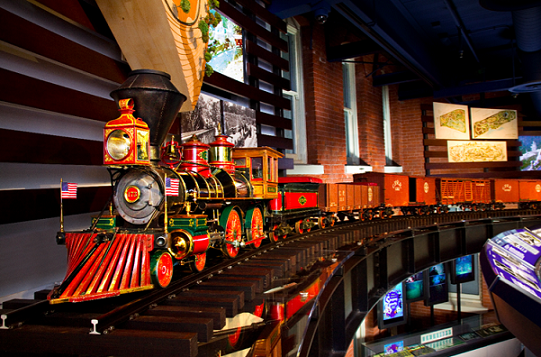 I
I
It’s not often that one sees Michael Labrie, Director of Collections for The Walt Disney Family Museum, visibly distressed, and I must admit, I never have. But while researching one of the Museum’s most treasured artifacts, the Carolwood-Pacific Railroad and the Lilly Belle, I learned that there was, in fact, a time when Michael was not his usual calm, cheery self. The situation involved the installation of the train that was Walt’s pride and joy during the months prior to our museum’s opening in 2009. In preparation for this month’s Look Closer presentations, which focused on the Carolwood Pacific Railroad, I asked Michael to meet in Gallery 9 to discuss this artifact, one that has enjoyed a rich and interesting personal history with Walt. And it was during our conversation that Michael revealed how difficult it was for him to watch the priceless train being lifted from the top of the gallery ramp to a track located several feet across the ramp—and above a looming open space.
Previously, special measures had been taken to prepare for the Carolwood Pacific’s installation. A small rig had been constructed to transport the train from the Gorgas Street Warehouse in the Presidio, where it had been restored, to its new home in our museum; and scaffolding and an "I" beam had also been placed around the area in Gallery 9 where the installation was to occur. Because of the weight of the train—the Lilly Belle by itself weighs approximately 250 pounds—and because of the delicate nature of the artifact, it was immensely challenging to move the pieces across what Michael referred to as “the great divide.” Using the "I" beam, and working with one section at a time, the team from the professional fine art moving company of Atthowe Fine Art Services, hoisted the train from the rig situated on the ramp, and then lowered it onto the track. Michael confessed that the grueling process of mounting the train seemed to age him. Michael Campbell, President of the Carolwood Pacific Historical Society, who was also present for the installation, said it was “a tense moment when they moved the Lilly Belle onto the track.”
What also contributed to their discomfort was the fact that at one point during the moving process, the train derailed. It became apparent that there was an error with the consistency of the gauge, which quickly caused the derailment. Before the train's installation could continue, every inch of the track had to be remeasured and the gauge corrected. Once that problem was solved, airplane cables were fastened on every other axle of the train to secure the cars to the tracks and prevent rolling. Wheel chocks were also installed at various points to reinforce the train’s stability.
Fortunately, any concerns Michael Labrie had regarding the overall condition of the Carolwood Pacific were addressed long before the official installation at the Museum. When the train first arrived at the Gorgas Street Warehouse, where other items in the Walt Disney Family Foundation’s collection were being stored, it was dirty and in need of repair. Window panes needed to be repaired, parts needed to be fabricated, and the engine's cabin roof needed serious conservation. Sean Bautista, who had worked on Disneyland trains and John Lasseter’s personal railroad, was brought in to do fabrication. Arts conservator Tonja Morris, who specializes in 3-D objects, spent months cleaning the various cars and repairing the Lilly Belle’s cab.
Today, the long-beloved train rests beautifully on its track overlooking The Walt Disney Family Museum’s largest gallery. Led by the gleaming Lilly Belle, with its hand-painted headlamp and brass-and-red sand dome with gold striping; the Carolwood Pacific Railroad never fails to catch a visitor’s attention. Now, whenever Michael Labrie walks by the impressive display, he feels proud—and much more relaxed.

Mary Beth Culler
Museum Interpreter
